Why You Should Keep Instant Dashi in Your Pantry
Dashi is the foundation of Japanese cuisine, but its potential uses go well beyond that. Here's how to use the ever-versatile instant stuff.
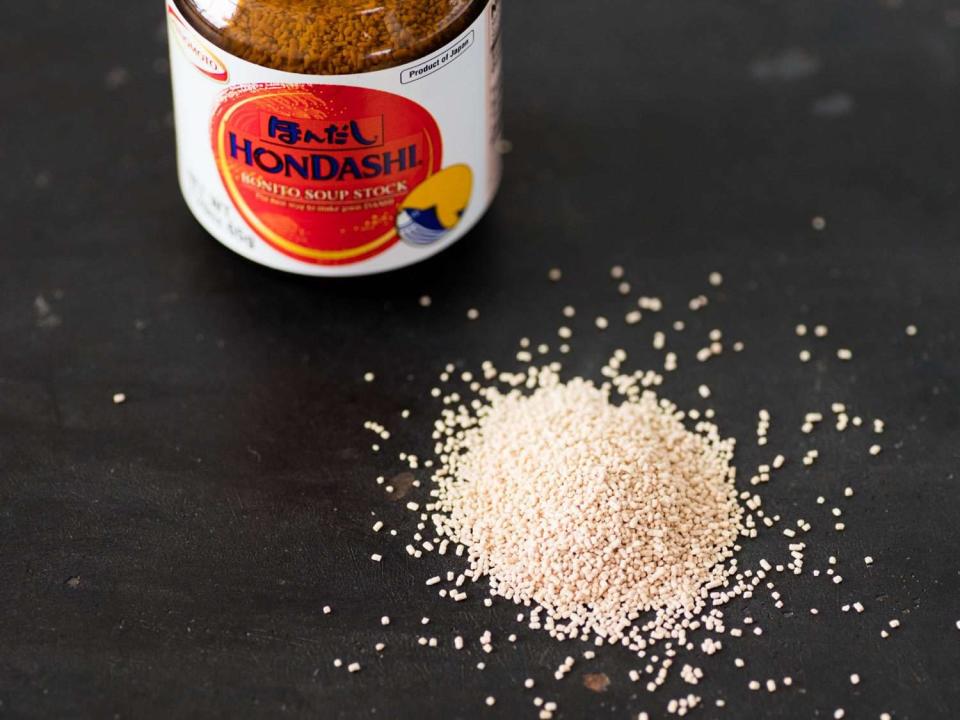
Serious Eats / Vicky Wasik
One of the biggest stumbling blocks home cooks encounter as they try to diversify their culinary repertoire isn't acquiring the unfamiliar ingredients they need—it's figuring out how to get the most use out of them.
This is one of the reasons we try to put together ideas for how to use up specific ingredients. It's not just to help you make sure they don't go to waste after you've tried out one recipe, but also to offer a kind of general guide to the advantages of keeping them around, since most every pantry ingredient can be used in myriad ways; see, for example, our article on all the ways you can use fish sauce, or this article about the versatility of baking soda. And the same is true of instant dashi.
You can read our extensive primer on dashi, the broth based on kombu and dried bonito (katsuobushi) that's integral to so many Japanese dishes, if you want to make your own from scratch. But many on our recipe team, as well as many Japanese home cooks, rely on an instant form of dashi sold by Ajinomoto under the name "Hondashi" at Amazon.* It is to dashi what bouillon cubes are to stock, and, in a pinch, it can be a meal-saver—simply add one teaspoon of the powder to a cup of warm water, and you have your dashi.
If you look at the ingredient label, you’ll see that Hondashi is a mixture of the flavor enhancers MSG (which mimics the glutamic acid in kombu), disodium inosinate, and disodium succinate (which mimic the flavor profile of katsuobushi), along with salt, sugar, yeast extract, and dried-bonito powder and extract. To put it bluntly, it’s an umami-bomb powder meant to create a highly flavored liquid, which you can then use to flavor anything and everything.
There are other brands, some of which, like this one from Yamaki at Amazon, come in the form of a kind of tea bag.
In that, it is similar to clam juice as a flavor enhancer, but a bit more versatile: Its seafood flavor isn't as pronounced, and it has a little smokiness that complements a wide variety of meats, seafood, and vegetables. And, while it's particularly useful for Japanese or Japanese-inspired recipes—think soba, okonomiyaki, and gyudon—it can be used as a substitute for other liquids in Western recipes, too. Try using it instead of water or milk for cooking creamy polenta, as a poaching liquid for fish and shrimp, or for deglazing when making pan sauces.
If you've ever wondered about how to incorporate more dashi into your cooking life—or if you want to try out dashi for the first time, but don't want to commit to buying the kombu and katsuobushi and making it from scratch (which is actually pretty simple, but I understand the hesitation)—here are seven uses to illustrate how versatile dashi, and thus Hondashi, can be. Once you've gotten hooked on instant dashi, you can consider graduating to using freshly made dashi all the time—though maybe keep a jar of instant on hand, just in case.
Okonomiyaki (Japanese Cabbage Pancake)
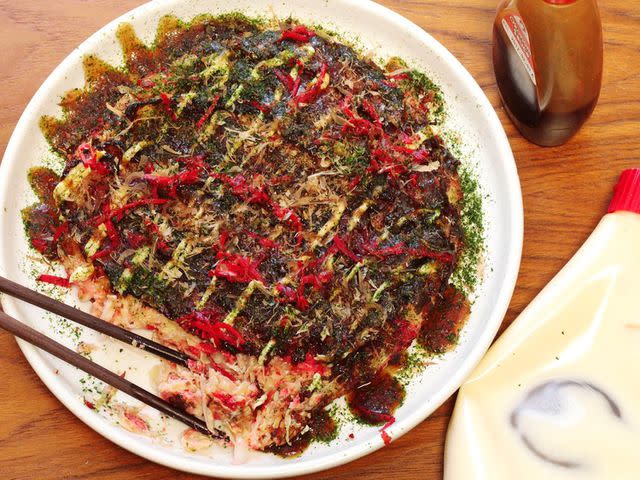
Serious Eats / J. Kenji López-Alt
Okonomiyaki is a savory Japanese cabbage pancake, often cooked with some kind of pork—usually pork belly, but sometimes bacon—annealed to its surface. It's most often served with a showering of katsuobushi flakes on top, along with sweet-savory soy-based okonomiyaki sauce and MSG-laden Kewpie mayonnaise. This recipe uses dashi as part of the liquid component in the batter, adding an extra layer of deep savoriness to the resulting pancake. It isn't strictly necessary—water can be used just as easily, and there's a lot of savoriness to be had in the other ingredients—but the addition of dashi definitely makes the dish more intriguing.
List Link: Osaka-Style Okonomiyaki (Japanese Cabbage Pancake) Recipe
Ohitashi
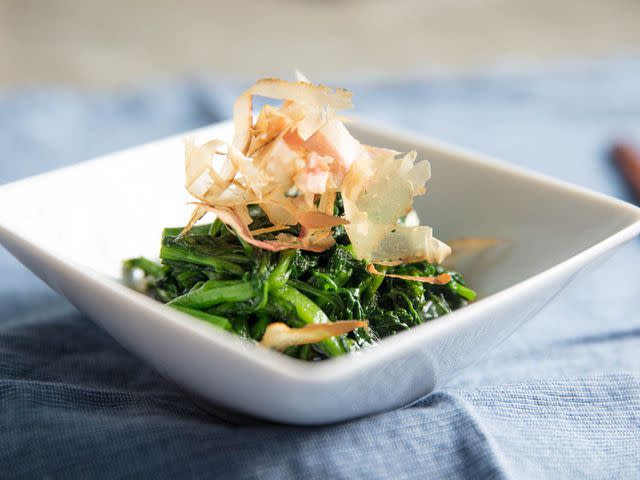
Serious Eats / Vicky Wasik
Ohitashi is more of a technique than a dish, since it can be made with any kind of blanched green, and even other types of blanched vegetables. It calls for making a deeply flavorful liquid from dashi, soy sauce, and mirin, then soaking the cooked vegetables in that liquid. With instant dashi on hand, simple blanched vegetables can be transformed into an incredibly satisfying side dish in just the time it takes to soak them in the liquid, which is about 30 minutes.
List Link: Ohitashi (Japanese Blanched Greens With Savory Broth) Recipe
Miso Soup
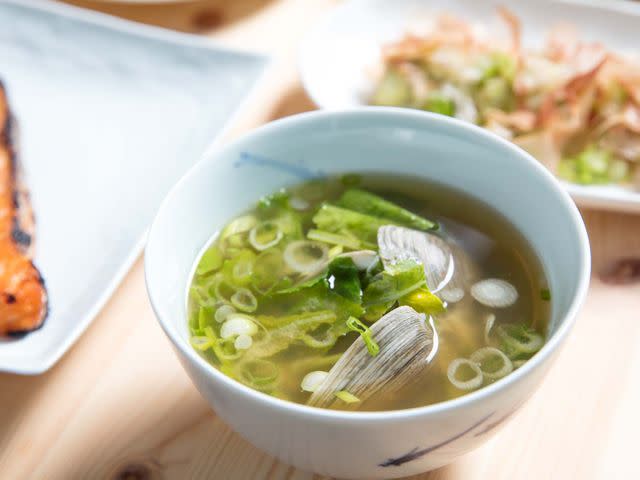
Serious Eats / Vicky Wasik
If you have instant dashi on hand, you're very close to having instant miso soup on hand, since miso soup is just miso stirred into dashi. One of miso soup's less appreciated qualities is how infinitely variable it is; you can add almost anything to it, so it's a great way to use up leftovers or vegetables that have been sitting in your refrigerator for a bit too long. Have some old mushrooms in there? Slice 'em up and toss 'em in the pot. Leftover pork? Ditto. Leftover pork stir-fry? Even better. Of course, we have a couple recipes that are a bit more traditional, but the combination of dashi and miso can really accommodate almost anything you've got lying around.
List Link: Easy One-Pot Miso Soup Recipe
Chawan Mushi
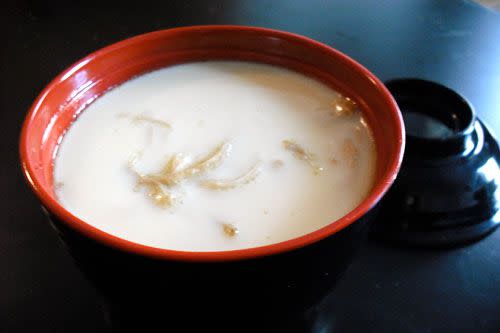
Serious Eats / Chichi Wang
Chawan mushi is a savory steamed custard made with dashi and eggs, flavored with mirin and soy sauce. What distinguishes it from other egg custards is its relatively high proportion of liquid to egg, which, when the mixture is steamed until just set, produces an exceedingly wobbly and ethereally light texture that melts in your mouth. Often, mushrooms and shrimp (or poached chicken) are added to the bottom of the container in which the custard is cooked, but you can really add any ingredients you have lying around. (The exceptions are those ingredients with a very high water content—uncooked button mushrooms, for instance—since they'll throw off the liquid ratio, resulting in a watery and bland mess.) Chawan mushi can be served hot or cold, and can make an elegant and simple addition to any meal, so long as you have eggs and instant dashi around.
List Link: Chawan Mushi
Noodles
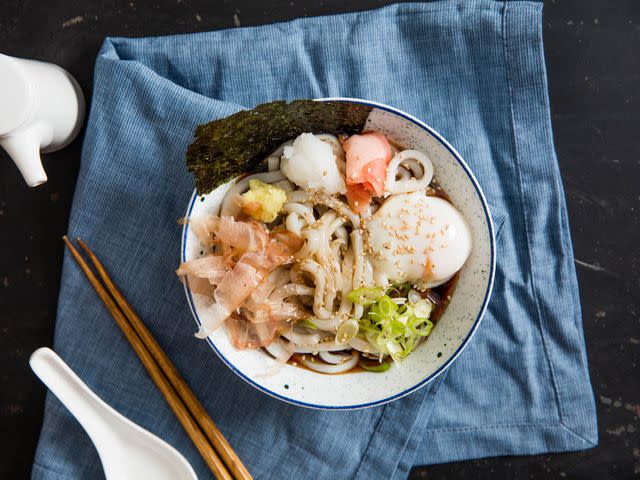
Serious Eats / Vicky Wasik
Dashi is an essential component in many of the noodle dishes that Japan is famous for: soba, ramen, and udon. If you have instant dashi around, and you have dried noodles around, you can make a noodle dish in about the same amount of time as it takes to cook the noodles. We have recipes for bukkake udon, cold soba, and our version of shin ramyun, all of which use dashi, and in all cases you can easily substitute instant.
Okay, so shin ramyun isn't a Japanese dish, but that brings up another way in which instant dashi is versatile: In a pinch, it can serve as a decent replacement for the seaweed and anchovy stock commonly used in Korean cooking, since it has a similar flavor profile. Try it in this recipe for soondubu jjigae (Korean soft tofu stew).
List Link: Bukkake Udon (Japanese Cold Noodles With Broth) Recipe
List Link: Classic Cold Soba Recipe
List Link: Homemade Shin Cup-Style Spicy Korean Ramyun Beef Noodle Soup Recipe
Arugula, Sweet Potato, and Walnut Salad With Dashi "Vinaigrette"

Serious Eats / Vicky Wasik
An example of how dashi can be just as useful in a Western kitchen as it is in a Japanese-influenced one, this salad uses a soy sauce–flavored dashi in place of a vinaigrette. It's a perfect starting point for your own experiments with introducing dashi as a flavoring agent into dishes you may think of as distinctly Western.
List Link: Arugula, Sweet Potato, and Walnut Salad With Dashi "Vinaigrette" Recipe
Miso, Pork, and Walnut Dip for Vegetables
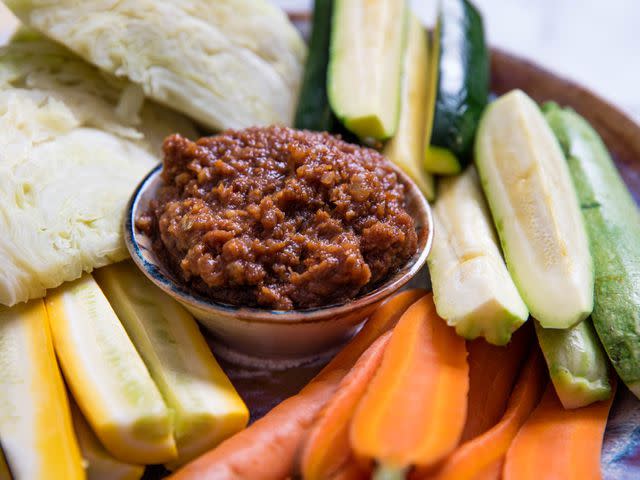
Serious Eats / Vicky Wasik
This recipe is a perfect illustration of how to use dashi as a kind of hidden flavoring, letting its savoriness act as a complement to the more overt flavors in a dish. It's also one of those instances in which an instant dashi might be more useful than one made from kombu and katsuobushi, since such a small amount is used. On that note, it's a great starting point for figuring out how to add small quantities of dashi simply as a flavor enhancer, similar to the way we use fish sauce to enhance the savoriness of classic Italian-American red sauce or pork chile verde.
List Link: Miso, Pork, and Walnut Dip for Vegetables Recipe
Read More
July 2018

